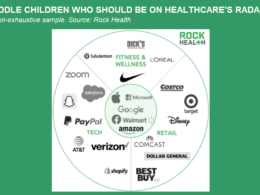This is a republication of the article “Ending The Epidemic Of “Magical Thinking” In Healthcare”, with the title above. The post is preceded by an Executive Summary, by the Editor of the Site.
inhealth — institute for health transformation
Joaquim Cardoso MSc
Founder, CEO and Senior Advisor
January 21, 2023
EXECUTIVE SUMMARY
The healthcare industry has been slowed by “magical thinking” in which: (1) inflated valuations were believed to continue rising forever, (2) patient-facing technologies were seen as panaceas for all healthcare issues, and (3) tech and e-commerce companies were believed to be the future saviors of healthcare.
- The venture bubble in healthcare has now shrunk and there is a scarcity of funding, causing a parallel reckoning to the crypto crash.
The industry is experiencing the first of what the author believes will be many big-deal hangovers.
- The Teledoc-Livongo merger initially created a company valued at $37 billion; now it’s worth around $4 billion.
- Will CVS one day wish for a mulligan on its $8 billion purchase of Signify?
The author believes that this end of easy money and magical thinking will bring a return to old-school wisdom in healthcare and recommends five basic elements for this return:
- (1) less virtue signaling and more real virtue,
- (2) less aspirational chatter and more talk about real problems for real patients and communities,
- (3) more self-reflection on why change is difficult in healthcare organizations,
- (4) more healthcare media focus on evidence of real patient impact, and
- (5) more leadership.
INFOGRAPHIC
TDOC Stock 3-Year Chart

DEEP DIVE

Ending The Epidemic Of “Magical Thinking” In Healthcare
Forbes
Sachin H. Jain
President and CEO, SCAN Group & Health Plan
January 20, 2023
Healthcare’s transformation has been slowed by “magical thinking.”
When the Harvard economist Mihir Desai last week heralded the crypto crash as the culmination of a 15-year long stretch of “magical thinking” in capitalism, he didn’t call out the healthcare industry directly, but he easily could have.
All the elements have been there in spades: the stubborn belief that absurdly-inflated valuations would continue rising forever; the embrace of patient-facing technologies as panaceas for a thousand healthcare ills; scope creep so extreme that tech and e-commerce companies whose greatest achievements and innovations are 20 years old were somehow anointed as future saviors of healthcare.
Talk about magical thinking.
And so, just as Bitcoin bros have been humbled by the crypto crash, we’ve witnessed a parallel reckoning in healthcare. The venture bubble, which swelled in 2021, has shrunk to anemic levels to the point where there’s a scarcity of funding that’s impossible to ignore. People who were holding their breath waiting for big tech to fix healthcare have finally exhaled.
The magical thinking of cryptocurrency has many analogs in healthcare.
Likewise, the industry is experiencing the first of what I believe will be many big-deal hangovers.
The Teledoc-Livongo merger initially created a company valued at $37 billion; now it’s worth around $4 billion.
Will CVS one day wish for a mulligan on its $8 billion purchase of Signify?
Maybe not — if it can make money selling hangover remedies to others who consumed enough Kool-Aid to open their wallets wide in the era of magical thinking.
The Teledoc-Livongo merger initially created a company valued at $37 billion; now it’s worth around $4 billion.

Joking aside, just as a five-alarm hangover can mark the start of better habits, …
… I’m hoping that the end of easy money and magical thinking in healthcare will bring with it a return to old-school wisdom that the industry in recent years lost sight of.
That wisdom, I believe, boils down to five basic elements.
- 1.First, less virtue signaling and more real virtue
- 2.Second, we need less aspirational chatter, and more talk about the real problems of real patients and real communities.
- 3.Third, more self-reflection on why change is difficult in healthcare organizations (and our personal role in slowing it).
- 4.Fourth, we need more healthcare media focus on evidence of real patient impact, less on gaudy funding announcements.
- 5.Finally, more leadership — and by that I mean Martin Luther King-type leadership, not glorifying the work of administrators and title-holders.
1.First, less virtue signaling and more real virtue.
We need to harness ourselves to the task of building high-trust companies that put patients before profits (or authentically places the two side by side).
Integrity doesn’t manifest in the pretty-sounding values and corporate pablum printed on company websites.
It shows up instead in the tough front-line decisions made daily by leaders, managers and clinicians — all for the betterment of patient care.
Show me a company that consistently promotes those virtues and I’ll show you a company worth betting on.
While we’re at it, let’s pump the brakes on our overblown rhetoric around value-based care, which cannot and should not be used as shorthand for doing the right thing in healthcare.
It’s a model to which I’ve devoted large chunks of my career, but it will only truly help us insofar as it reduces the overall amount of our healthcare spending, rather than simply redistributing dollars.
So let’s hold the model to that standard and see if it can actually earn the gold star treatment.

2.Second, we need less aspirational chatter, and more talk about the real problems of real patients and real communities.
Believe me, I get it.
Leaders often need to resort to lofty language and hyped up claims to cut through the endless media clutter, but it’s incumbent on us to ground such talk in reality, even when it’s not pretty.
Acting as if virtual visits or robotic limbs or million dollar therapies might address the industry’s most pressing needs is nonsense and ultimately helps only a few.
Acting as if virtual visits or robotic limbs or million dollar therapies might address the industry’s most pressing needs is nonsense and ultimately helps only a few.
More worrisome is how we have normalized overstated impact.
Theranos got a lot of attention for the pure unbridled fraud of its now notorious founder, Elizabeth Holmes.
But there are more than a few other companies whose claims don’t match up with the reality-leading us to believe (prematurely) that we are solving problems that remain as yet unsolved.
Let’s be better and hold companies and their leaders accountable for demonstrating real proof of their results.

3.Third, more self-reflection on why change is difficult in healthcare organizations (and our personal role in slowing it).
So no more acting as if one more conference will make the industry’s problems go away.
No more pretending that a breakthrough treatment published in the New England Journal of Medicine will suddenly and seamlessly merge into clinical care protocols the next day.
No more talking about innovation, health equity, and racial disparities on one day-and shamelessly slowing down progress towards advancing those ends the next.
No more pretending that a breakthrough treatment published in the New England Journal of Medicine will suddenly and seamlessly merge into clinical care protocols the next day.
No more talking about innovation, health equity, and racial disparities on one day-and shamelessly slowing down progress towards advancing those ends the next.
We need to move beyond Kiplinges que “Just-So Stories” and begin to acknowledge that the healthcare industry is a fractal problem like few others.
Ignoring its complexity only makes it harder to focus on the deeper work needed to spur real change, like fostering corporate cultures where truth telling eclipses ego-stroking; where disciplined design and commitment to continuous improvement trump the “good enough” mindset.

4.Fourth, we need more healthcare media focus on evidence of real patient impact, less on gaudy funding announcements.
We’re all complicit, too. We exacerbate the problem every time we click on a headline about some company’s latest funding round, or a clickbait piece about where the big money’s going next in healthcare.
Is it really newsworthy that Joe and Jane Smith raised $XM dollars for startup Y from Venture firm Z?
What does it say about our values when these stories are more interesting to us than the read-out of a NIH-funded randomized control trial of an intervention to reduce maternal and infant mortality?
What does it say about our values when these stories are more interesting to us than the read-out of a NIH-funded randomized control trial of an intervention to reduce maternal and infant mortality?
The next time you get to the end of a story and realize you’ve just wasted your click on such “news”, I challenge you to think twice before rewarding that site with your next click.
Let’s refocus our energies on what matters (hint: it’s patient impact)-and leave behind the fluff.
Let’s refocus our energies on what matters (hint: it’s patient impact)-and leave behind the fluff.

5.Finally, more leadership — and by that I mean Martin Luther King-type leadership, not glorifying the work of administrators and title-holders.
This means leaders who transparently, humbly, and candidly hold themselves accountable to their employees and boards of directors, as a way to establish similar expectations for the entire organization.
This means leaders who transparently, humbly, and candidly hold themselves accountable to their employees and boards of directors, as a way to establish similar expectations for the entire organization.
Leaders who aren’t above serving even when it goes against their own personal interest.
This is not some performative act; it’s true commitment to patient-centric work, and not some evanescent or magical thinking concept of healthcare that real folks never asked for and will never need, but which checks all the right boxes for investors.
This is not some performative act; it’s true commitment to patient-centric work, and not some evanescent or magical thinking concept of healthcare that real folks never asked for and will never need, but which checks all the right boxes for investors.
It’s a commitment to the gritty and hard work of changing incredibly complex, highly-regulated and sometimes calcified systems.
That’s anything but magical — until you witness healthcare that actually improves the lives of patients and their loved ones.
It’s a commitment to the gritty and hard work of changing incredibly complex, highly-regulated and sometimes calcified systems.
That’s anything but magical — until you witness healthcare that actually improves the lives of patients and their loved ones.
Then it’s as magic as it gets.
Originally published at https://www.forbes.com.












